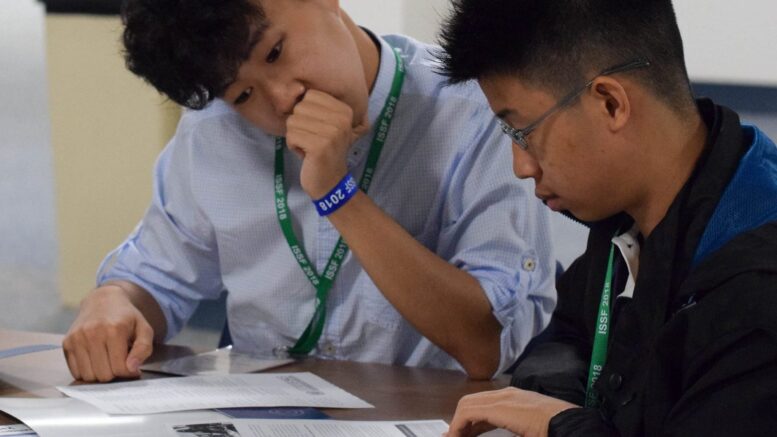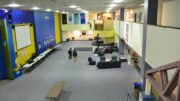Oh no! It’s 6pm, and even though you told yourself you’d finish that MI-2 problem set during your off-mods, you still haven’t actually looked at it yet. Ms. Dowling is long gone from IMSA; the math office is closed, and it feels like all hope is lost for your barely afloat MI-2 grade. Until you hear over the intercom that someone from your hall is peer tutoring MI-2 until 7. As if the problem-set gods heard your pleas, you run down to the hall commons to seek help.
The peer tutor program at IMSA provides students with a rich opportunity to not only practice teaching their peers but learn from their peers as well. I had the wonderful opportunity to interview Amy Keck, the learning strategies coordinator of the program, as well as Caleb Schlesser, the peer tutor liaison. Here’s what they had to say about the program.
What are the changes that have been made to the program?
Ms. Keck: This is my 11th year at IMSA and my 11th year assisting with this peer tutor program. As far as this year, I feel like it’s been the most improved, and it’s truly thanks to Caleb. But as far as implementation goes, thanks to Vincent You (’25), who is rolling out his peer tutor website. He and I have been talking off and on since he was a sophomore about doing this. We had staggered conversations, and it was a slow rollout, but finally, thankfully, we pushed it forward this year. So this is the first time the peer tutor website has been out. In addition to that, I think the overall marketing has been improved this year. Utilizing Adeola (’26), she’s been working with us to assist in creating the flyers, and she’s just a little bit more hip than I am, dare I say. She’s been instrumental in helping with the marketing piece of it, and it’s making sure that both online, bulletin boards around here, and in residence halls that we are continuing to update people about the cool things that we’re doing. Historically, we’ve had review sessions, we’ve had tutors, but the marketing piece hasn’t been the best. So I feel like this is the first year that I think it has been improved upon. Caleb has also done a great job, and I want to give credit where credit is due, as well as Stephanie Broy; she’s helped with bulletin boards in each hall that’s specific to peer tutors as well as making an actual peer tutor room.
Caleb: There is also a dedicated space between 7-9 p.m. during sophomore study hours that is reserved solely for peer tutor hours. In general, I’ve been trying to get the peer tutoring program more integrated with the broader residential life experience. Forthcoming, we will be having demonstrations on how to interact with the peer tutor program as a part of programming. And, in general, we are trying to formalize it and streamline the program as much as possible.
Ms. Keck: Additionally, with our review sessions, more students have been attending, and faculty have been better at assigning students to come if they feel that the student would benefit. That collaboration with faculty, us, the CACs, and the residential counselors is imperative to make sure the student gets the right support.
Why were the changes made?
Ms. Keck: I think every year there have been messages from tutors saying that there are no students showing up to receive help, and the students saying, “I can’t find any tutors.” This has happened every year, and both are not true because there were always tutors available and there were always students that needed a little bit of help. So that was always frustrating to me, and I know that in their lens it was true. But it was a flawed statement.
Caleb: The flawed statement is the lack of communication between those two groups, the peer tutors and students. The lack of a bridge to connect them.
Ms. Keck: So because of that, I wanted to really improve the marketing part. In all due respect, even with the residential team, every year it’s somebody different that I work with, and so finding a partner that was committed and passionate about the program has been very instrumental. Also, just to be honest, everything was very paper and pencil. But, using technology and our excellent students to create a website or somebody to help with the marketing, that’s been really helpful. I think that everything was very archaic, and it just hadn’t changed yet. So it’s just a matter of giving it the right time and attention that it needs.
Caleb: It’s also not change for the sake of change, but simply because the world is so much different than it was five years ago. The students of today interact with school in a completely different way than students did ten years ago when Ms. Keck came on. We needed to update the program, and I don’t think it has been since Ms. Keck had started.
Ms Keck: But it has mostly been little tweaks. There were so many iterations, but the one thing that stayed the same was focusing on our needs. We’ve tried main building tutors, then hall tutors; we’ve done LEAD tutors, but now it’s just stripping it down and simplifying it, and making sure we answer the question: What are the things that we need? We need quality tutors; we need students to feel comfortable to interact with the quality tutors, and we need to make sure that both parties know how to interact with each other.
How do they positively benefit the peer tutors?
Caleb: I just put out a form yesterday with regards to general feedback on the program coming forward. I’m sure they have opinions; IMSA students are very opinionated. But, at this time, we are in the process of listening to that feedback and collecting it. We are going to have a debrief on that next week, and we’re looking to have a community come together for the program as a whole to discuss these changes. What’s working, what isn’t working. So, the answer is still to be determined. I haven’t been checking in with the tutors as frequently as I’d like due to limited bandwidth, but I have managed to touch base with them at least once a week, sometimes more.
Ms. Keck: Because of that lack of time, it’s been difficult having the peer tutor liaison actually checking in to see if the tutors and students are showing up.
Caleb: Certain halls have a lot of students participating in the program and certain halls don’t. 1505 and 1507 seem to be magnet spots for the program.
Are you planning on making any more changes for next year?
Ms. Keck: Well, it’s not a change, but juniors and seniors that aren’t tutors can look for spring tutor applications for those who didn’t apply for the fall and were hired in the fall. We are going to be rolling that out in the next week or so. So if anybody who is an upperclassman wants to apply, we encourage them to do so.
Caleb: Lots of things have been a slow rollout too. There’s stuff we’ve been planning on doing that is happening. Tweaks to the referral form, tweaks to the logging procedure—that’s still being done on pen and paper. I have ideas for ways on how to integrate with some of the other software that you all use on a day-to-day basis. I, as a very new RC, am still getting used to how things work, so I don’t want to rock the boat too much until I have a feel for the foundation.
Finally, to end the interview off with some parting words,
“[The Peer Tutor Program] enhances the level and sense of community–providing a safe space for students to connect, collaborate, and meet each other that may not have crossed paths otherwise. Especially for sophomore students to an upperclassman. But even a junior to a senior, a senior to a junior–I think it’s a safe way to continue to improve the sense of community around here.”
-Amy Keck, Peer tutor learning strategies coordinator
So instead of trying to procrastinate your AdChem worksheets, you should reach out to a peer tutor for help to have one less thing on your to-do list. Regardless of if you’re a sophomore, junior, or senior, reaching out when you have questions and need help is always going to benefit you more than hurt you.






Be the first to comment on "Peer Tutor Updates: What to Know About the Program"